A Perplexing Nexus Between Three Neurological Diseases: Alzheimer's, Parkinson's and Huntington's
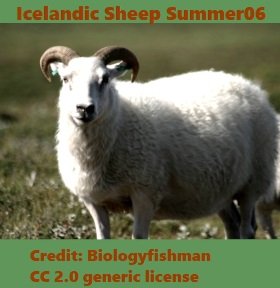
A few weeks ago I wrote a blog, "The Genius of Sheep". I learned that not only are sheep very smart, but they also may hold promise of a treatment for Huntington's Disease. Huntington's is a particularly cruel disease because its victims know what their fate will be. They will likely have watched a grandfather, mother, uncle or sister decline and die from the illness.
I was both interested to find out more about this sheep substance and was also skeptical of the claims for its curative powers. There's money to be made from raising the sheep and from extracting and marketing the substance.
However, I didn't understand the pathology of Huntington's, or neurodegenerative diseases in general. If I was going to write a blog--and that did become my ambition--a lot of work lay ahead. After doing that work, I learned one thing for certain: there is a profound gulf between what scientists know about neurodegenerative diseases and what they need to know in order to significantly help patients. Effective treatment, and even a cure, resides in bridging that gulf.

I think the first person who brought the tragedy of Huntington's Disease home for me was Woody Guthrie. Guthrie was a folk singer and political activist who battled Huntington's for the last years of his life. He died in 1967. Two of his children died of the disease, and his father did also.
GM1 Ganglioside
My quest for understanding the mechanics of Huntington's and other neurodegenerative diseases began with research into the mysterious sheep substance, GM1 ganglioside. This substance is found not only in sheep, but also on cell membranes of all animals. GM1 performs many functions throughout the body, but plays an especially important role in signalling: it helps nerve cells (neurons) to communicate with each other, to receive and transmit messages.
A Critical Balance
Nature, it turns out, is whimsical in its distribution of GM1 ganglioside. Some people have too much---- that's called gangliosidosis--and some people have too little.
Among the people who have too little are those afflicted with Parkinson'sand Huntington's. This is where sheep come into the picture, because some of them have gangliosidosis-- way too much GM1 ganglioside. This is a genetic affliction. By manipulating the genes of sheep--creating transgenic sheep--scientists are able to produce whole flocks that have gangliosidosis.
Trials were conducted in which mice suffering from Huntington's were given ovine--sheep-- GM1 ganglioside (directly into the brain). These mice showed significant improvement. There have also been trials that tested the effectiveness of GM1 ganglioside on symptoms of Parkinson's disease. This research used human subjects. Bovine--cow--ganglioside was used. The results of these trials showed that GM1 did ameliorate symptoms of Parkinson's.
Bovine GM1 is no longer used because of mad cow disease (the material is harvested from brains). If GM1 is to be used therapeutically, it will have to come from sheep.
Tay-Sachs Disease: A Hereditary Gangliosidosis in Humans
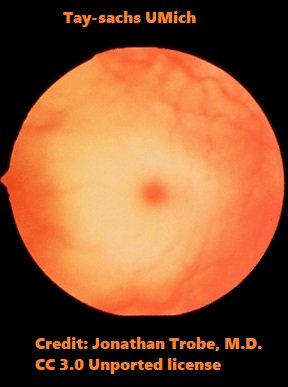
Tay-Sachs is an autosomal recessive disease, which means a child has to inherit two copies of the gene to be affected. Hallmark cherry-red spots may be evident the eyes of those afflicted. Children usually do not survive past early childhood.
GM1 Ganglioside and Alzheimer's
It's important to note that what may be therapeutic for one neurodegenerative disease may have the reverse effect in another. An illustration of this: recent research indicates that GM1 ganglioside may actually accelerate the development of Alzheimer's disease. The destructive beta-amyloid protein (hallmark of Alzheimer's) binds to GM1 ganglioside in the brains of Drosophila--the fruit fly. The is significant for people because it turns out that the neural connectivity of a fruit fly is remarkably similar to a human's. So research on the fruit fly brain, it is believed, offers good insight into how human neuron messaging works. If beta-amyloid binds to GM1 in a fruit fly's brain, it may show the same inclination in humans.
Fruit Fly
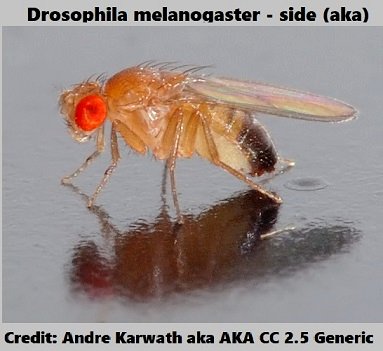
So GM1ganglioside may help alleviate symptoms of Parkinson's and may accelerate the progress of Alzheimer's. We know that it alleviates symptoms of Huntington's. How? I pulled up an article that described the neutralizing effect of GM1 on the disease causing-agent in Huntington's, a protein called mutant Huntingtin (mHTT). According to the article, in studies on transgenic mice (bred to have the disease) infusion of GM1 into the brain weakened the toxic effects of mHTT. Treated mice demonstrated normal motor function.
Transgenic Mice with Huntington's
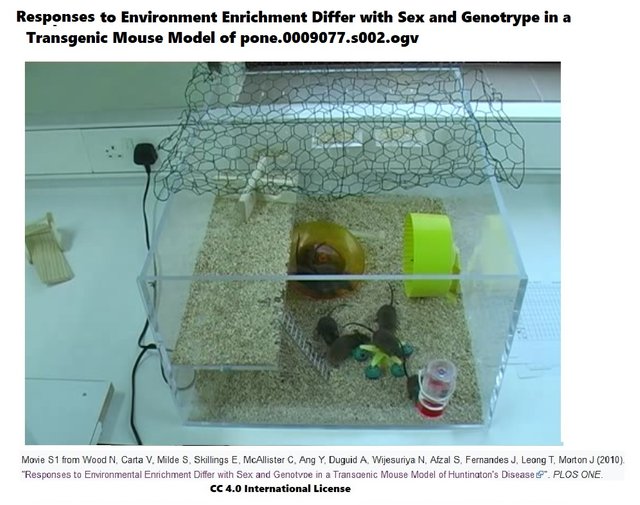
These mice were bred with the mutant HTT gene. They are part of an experiment to see if environment can influence the progress of the disease. This video shows the mice interacting in what is described as their playground.
Where does all of this information leave researchers? It leaves them with a lot of unanswered questions. It's obvious that GM1 ganglioside has great potential as a subject of research. Will that research lead to understanding neurodegenerative disease? Will it lead to treatments, or cures? Some people think so. At the moment transgenic sheep (sheep bred with the gene to develop gangliosidosis) are being raised with the hope that they will be part of a treatment plan for Huntington's and Parkinson's diseases.
Neurodegenerative Diseases
Neuroconnectivity: it is the basis of the communication network that keeps our bodies functioning.
A Ballet in Which One Misstep Brings Disaster
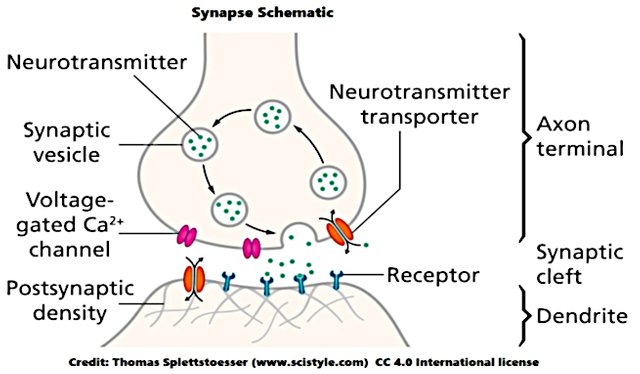%20CC%204.0.jpg)
As I look at this diagram, I am struck by how ordered it seems. The role of each part of the synapse is so clear. And then my eye catches one piece,"Voltage Gated Ca2+ Channel". This is such a small part, so easy to overlook. And yet, this one piece once held the key to my brother's future. A few years ago, a mysterious encephalitis suddenly overcame him. It defied diagnosis. He had seizures, dementia, movement disruption. Then a brilliant doctor put the bits of the diagnostic puzzle together and concluded that my brother had autoimmune voltage-gated encephalitis. A tiny piece of the synapse, shown in the illustration, was being attacked by my brother's own immune system. Massive doses of immune suppressive drugs, and plasmapheresis, stopped the attack.
The Synapse
The basic function of a neuron is to transmit information. The transmission of information between neurons occurs across a tiny space, a synapse. This transmission is dependent upon a host of factors, including neurotransmitters, which are like chemical railways. They carry information from one neuron to another.
In 2016 a group of neuroscientists got together to consider disturbances in synapses as a unifying characteristic of neurological disorders. The featured topic at the 2016 symposium was Synaptopathies: synaptic dysfunction in neurological disorders. A report came out of the conference. This suggested that a clue to causes, treatments and cures for many diseases of the brain might be found in studying synapse disturbance. The conferees were not only addressing neurodegenerative diseases, but also other conditions such as Downs Syndrome, autism and epilepsy.
Neurodegenerative
Three neurodegenerative diseases already mentioned in this post--Alzheimer's, Huntington's and Parkinson's--are often compared with one another (by neurologists). It is thought that in understanding the process that leads to illness in each of the three, an understanding of the underlying disease processes for all may emerge.
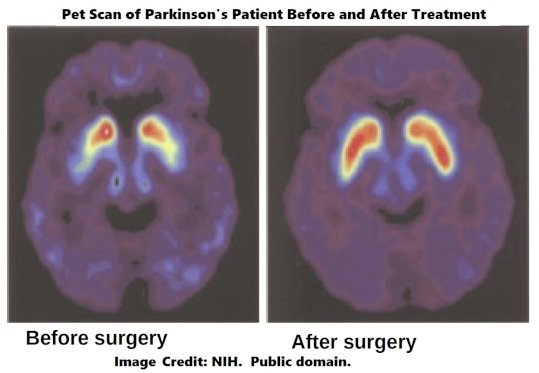
In Parkinson's Disease there's a disruption in dopamine delivery because dopamine receptors are destroyed. One therapeutic approach is to implant fetal tissue in the brain of a patient. In these before and after images, you can see that there is an increase in dopamine uptake a year after the surgery.
Amyloid Proteins
A recent study (2017) discovered a significant similarity between the way these three neurological diseases spread through the brain (and also chronic traumatic encephalopathy-- injury from sports concussions). In each case there seems to be a rupture within a cell that has encircled a pathogenic protein. The rupture results in dispersal of the disruptive protein. In the case of Parkinson's the protein is α-Synuclein, in Huntington's it's polyglutamine-expanded huntingtin, and in Alzheimer's it's β-amyloid and tau.
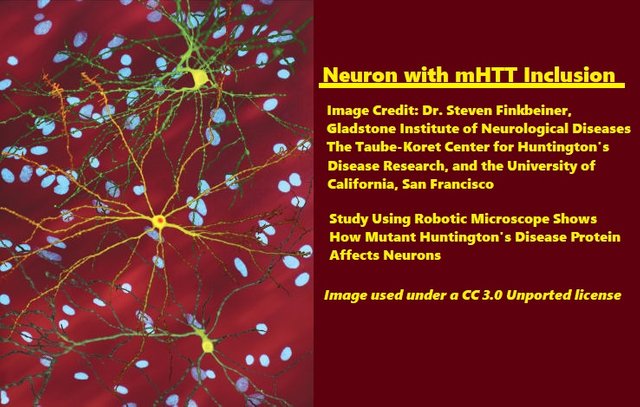
This is a montage of three images showing neurons affected by the mutant HTT protein. The yellow orb with tendrils is an affected neuron. The orange blob in the middle of that orb represents huntingtin proteins (HTT) collecting together abnormally in an inclusion.
One result of this blossoming protein field is plaque formation, or protein clumping. Although many of us have heard that plaques are a diagnostic feature of Alzheimer's, these plaques are also present in Huntington's and Parkinson's.
In Huntington's the aggregation of proteins in the brain is referred to as "clumping".
A factor the three disease have in common is cell death. In each of the three diseases a misfolding protein has been identified as instigating cell death. A 2013 article in "Frontiers in Molecular Biosciences" states, "...there is increasing evidence that in general, smaller soluble toxic misfolded oligomers are the main causative agent for neurodegeneration."1
Glutamate: An Essential Neurotransmitter
Glutamate: Not Enough in Huntington's. Too Much in Parkinson's and Alzheimer's
Glutamate is a vital neurotransmitter. We need it in our synapses—80% of all messages sent from one neuron to another use this neurotransmitter.
Glutamate is excitatory, which means it promotes action. Even though it is an amino acid, we can't get it from our diets because of the blood brain barrier. So we have to manufacture it, in our brains. This happens in an exquisitely balanced process called the Glutamate-GABA-Glutamine Cycle. An important part of that cycle is the astrocyte, a cell that is abundantly dispersed throughout the brain.
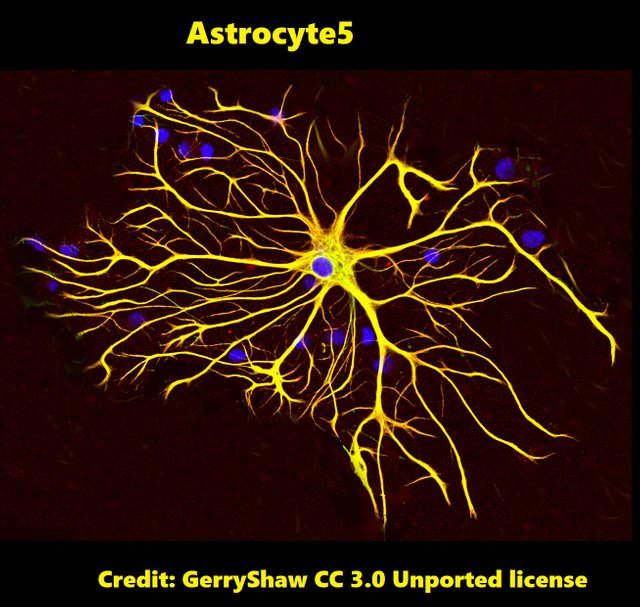

Huntington's: Not Enough
The astrocyte is like a transfer terminal. Once glutamate has been used in a synapse, it is sent over to an astocyte for processing. Processing means converting glutamate to glutamine, and then sending the glutamine off to a neuron, where it will be changed back into glutamate. This keeps the brain humming with enough glutamate to carry on its work effectively.
However, sometimes the glutamine never leaves the astrocyte. If that happens, then new glutamate won't be made, and there will be a deficit of this vital neurotransmitter. That's exactly what happens in Huntington's. With a deficit of glutamate, there is a disruption in the transmission of nerve impulses.
Parkinson's: Too Much
As has already been established here, glutamate is an excitatory neurotransmitter. There are also inhibitory neurotransmitters. These depress activity. An important inhibitory transmitter is GABA. Ideally, these two neurotransmitters--a positive and a negative, an excitatory and inhibitory--will be in balance. In Parkinson's that balance is disrupted in favor of glutamate. There's too much excitatory transmission. So much excitement, that neurons are damaged, and even killed.
This is where GM1 ganglioside seems to be helpful. It seems to have anti-excitatory properties and neutralize the effects of glutamate. This will spare nerve cells that would otherwise die.
Alzheimer's: A Devastating, Unregulated Release
In Alzheimer's, there is also a toxic bombardment of excitatory glutamate The result is the death of neurons and loss of function. Some medicines that have been formulated to ameliorate (temporarily) the symptoms of Alzheimer's symptoms try to stem the unregulated flow of glutamate.
Causes
Of the three diseases considered here--Alzheimer's, Huntington's and Parkinson's--only the cause of Huntington's can be explained with absolute clarity. It is a genetic disease. It is dominant, which means, if you inherit the disease from either parent, you will become ill. The disease is caused by a mutant gene, huntingtin (there are normal huntingtin genes, also.) The severity of the symptoms is influenced by the number of generations that have passed it along. The more generations, the more severe the disease is likely to be. Although becoming symptomatic is inescapable for those who inherit the gene, apparently environment can play a role in modifying the course of the disease.
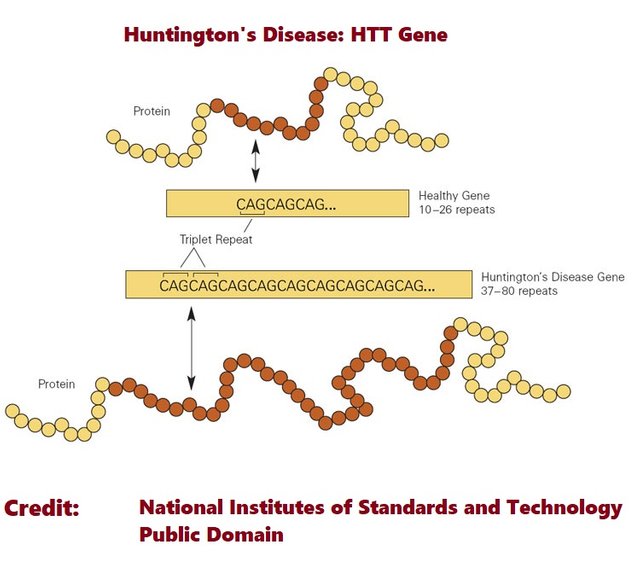%20National%20Institute%20of%20Standards%20and%20Technology%20public.jpg)
The red dots show a section of the gene called CAG (cytosine-adenine-guanine) sequence. The top gene is a normal huntingtin (HTT) gene. The bottom gene is the mutant huntingtin (mHTT). Note several repeats of CAG in the mutant gene. The more repeats of CAG in the gene, the more severe the disease will tend to be. With each generation that passes Huntington's along, repeats are added.
Alzheimer's also has a genetic component, although this is not a direct cause and effect relationship as it is in Huntington's. There is familial Alzheimer's. But, as with Huntington's, it seems that lifestyle can influence the age of onset and the course of the disease.
Formation of Plaques in Alzheimer's
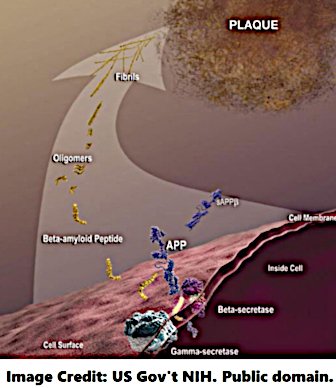
In the diagram you can see a protein,Beta-amyloid 42, breaking off and joining together with others to make plaques--a hallmark feature of Alzheimer's Disease.
Of the three diseases, Parkinson's has the least clear genetic association, although there are families where it does seem to occur more frequently. There is also Familial Parkinson's, which is caused by a gene mutation. In most cases, environment and experience are believed to play a significant role in the development of Parkinson's disease.
I began writing this blog because I had questions. The questions began with GM1 ganglioside, but in order to understand that I need to learn more about neurodegeneration. This is not one disease, or three diseases. Each disease, it seems teaches us about the others. In reading different articles--and I was sure to reference those published in the last couple of years--so much information was speculative, or tentative. It's obvious that our understanding the brain, the part of our bodies that controls everything we do and know, is in its infancy.
I can't leave this post without acknowledging a debt to the animals that have suffered and died so that we may understand ourselves.

Sources
I did a lot of background reading for this piece. Most of the sources mentioned here were directly referenced.
One of my sources was @chappertron. He described (in one of his comments) the effect that varying levels of glutamate had on different animals. That sent me reading in a very productive direction. Thank you, @chappertron!
References
Footnote
1 Frontiers in Molecular Biosciences Protein Misfolding and ER Stress in Huntington's Disease Talya Shacham, Neeraj Sharma, and Gerardo Z. Lederkremer
Sources
The Guardian: Scientists deploy GM sheep in fight to treat Huntington’s disease
Aljazeera: The lost years of Woody Guthrie: The singer's life in Greystone Hospital
Oxford Academic: Glycobiology Gangliosides as components of lipid membrane domains
Frontiers in Molecular Neuroscience Role of Metabotropic Glutamate Receptors in Neurological Disorders
Advances in Experimental Medicine and Biology Ganglioside Receptors: A Brief Overview and Introductory Remarks
Cells How Do Gangliosides Regulate RTKs Signaling?
GARD GM1 gangliosidosis
Progress in Molecular Biology and Translational Science Gangliosides, α-Synuclein, and Parkinson's Disease
Huntington's Disease in High Definition Disease-modifying effects of ganglioside GM1 in Huntington's disease models
EMBOPress Disease‐modifying effects of ganglioside GM1 in Huntington's disease models
Journal of Evolutionary Biochemistry and Physiology Protective effect of GM1 ganglioside against toxic effect of glutamate on cerebellar granule cells
Journal or Neurological Science A Randomized, Controlled, Delayed Start Trial of GM1 Ganglioside in Treated Parkinson’s Disease Patients
Glyco Science Research, Inc. Executive Summary of Ovine GM1 Ganglioside Project
Arq Bras Oftalmol 'Cherry red spot' in a patient with Tay-Sachs disease: case report
Scientific Reports Induction of ganglioside synthesis in Drosophila brain accelerates assembly of amyloid β protein
Neuroscience News and Research Unlocking the Secrets of Brain Organization -in the Fruit Fly
YouTube Michigan Breeders Aim to Cure Huntington's
Cold Spring Harbor Perspectives on Biology Voltage-Gated Calcium Channels
Critical Care Clin. The Role of Plasmapheresis in Critical Illness
Northwestern University Synaptopathies: synaptic dysfunction in neurological disorders – A review from students to students
Concussion Legacy Foundation What is CTE?
Loyola University Endocytic Vesicle Rupture in the Pathogenesis and Propagation of Neurodegenerative Proteinopathies
Neurology Propagating prion-like amyloid proteins invade target cells through endocytic vesicle rupture
Cold Spring Harbor Perspectives in Medicine α-Synuclein in Parkinson's Disease
Molecular Cell ArticleA Liquid to Solid Phase Transition UnderlyingPathological Huntingtin Exon1 Aggregation
Medical Press The 'Big Bang' of Alzheimer's: Scientists ID genesis of disease, focus efforts on shape-shifting tau
BrightFocus Foundation Amyloid Plaques and Neurofibrillary Tangles
Science Daily Structure of brain plaques in Huntington's disease described
Movement Disorder Amyloid deposition in Parkinson Disease and Cognitive Impairment: A Systematic Review
Annual Review of Genomics and Human Genetics Protein misfolding and human disease
Frontiers in Molecular Bioscience Protein Misfolding and ER Stress in Huntington's Disease
The Brain From Top to Bottom Synapses
Cold Spring Harbor Perspectives in Biology The Blood–Brain Barrier
Neuroscience Online Introduction to Neurons and Glial Cells
Science Daily New piece in the Huntington's disease puzzle
Psychology Today Your Brain on Alcohol
Hindawi: Parkinson's Disease Metabotropic Glutamate Receptors for Parkinson's Disease Therapy
Karger Pharmacology Advances in Drug Development for Parkinson's Disease: Present Status
Frontiers in Neuroscience: Neurodegeneration The Role of NMDA Receptors in Alzheimer’s Disease
Alzheimer's Association Medications for Memory
GARD Huntington Disease
National Institute on Aging: Causes of Alzheimer's Disease Alzheimer's Disease Genetics Fact Sheet
National Institute of Aging What Happens in the Brain with Alzheimer's
Science Daily Mechanism of familial Parkinson's disease clarified in fruit fly model


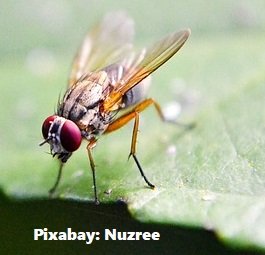
Awesome post! You did a really good job of taking a SUPER complex topic and making it accessible to regular folks, like me. My family history includes several relatives who developed dementia. It's good to see there may be some big breakthroughs in that area before I get to the age where it will affect me.
I appreciate that very much. I started with questions and traced my path carefully. The language is clear because I needed to understand as I explained it. I'm 'regular' too. My background is in literature and history, so much of the science terminology was new to me. But I love that, because my background is also in languages :) I hope you're right, that progress is quick in this area. People need help! BTW, Arlo Guthrie, Woody's son, never got tested for Huntington's and he is alive today (born in 1947). So sometimes things work out and genes are not destiny.
Have a wonderful day.
Excellent research and information! My mother had Alzheimer's, and a friend of mine had a mother with Parkinson's, so this was very interesting to learn! 🙌
Thank you! We need so much more research. I'd like to talk about that in a future blog.
Hi @agmoore2!
Your post was upvoted by Utopian.io in cooperation with @steemstem - supporting knowledge, innovation and technological advancement on the Steem Blockchain.
Contribute to Open Source with utopian.io
Learn how to contribute on our website and join the new open source economy.
Want to chat? Join the Utopian Community on Discord https://discord.gg/h52nFrV
Thank you, utopian--very grateful, for the upvote and the appreciation.
This post has been voted on by the SteemSTEM curation team and voting trail. It is elligible for support from @curie and @utopian-io.
If you appreciate the work we are doing, then consider supporting our witness stem.witness. Additional witness support to the curie witness and utopian-io witness would be appreciated as well.
For additional information please join us on the SteemSTEM discord and to get to know the rest of the community!
Thanks for having added @steemstem as a beneficiary to your post. This granted you a stronger support from SteemSTEM.
Thanks for having used the steemstem.io app. You got a stronger support!
I loved posting on SteemSTEM.io. Thank you for your support. I'd like to add that mentoring had an influence here. @chappertron not only gave me clues, he also encouraged me and was accessible. I had the sense that if I asked questions, they would be answered. The dynamic here is the closest thing I've experienced to the university environment.
Hey @agmoore2,
Thanks for the article!
New account? Funny!
I interrupt my little Easter holiday just for this really special post. We have discussed this previously and it's getting even more interesting. Besides the fact that Huntington disease is a quite remarkable disease (the more repeats you got, the more intelligent you are, the higher is your risk) which is quite unique, the devastating effects are comparable to other diseases you mentioned. I think I never mentioned that I researched Amyloidosis-related proteins for years. While doing this I found that some of them are very good to prevent the onset of AD (for instance) but once the first fiber is formed these beneficial players worsening the symptoms. Therefore, it is always hard for researchers to explain the exact mechanisms. And especially AD is hard to access due to both abeta and tau. Maybe the difference of Gangliosides is because of the plaque location (tau is within the cell, Abeta outside !?!). I have to admit I never heard about this Ganglioside therapy before. But I will keep my eyes open. It's like a trip back into my past. Pain and joy at the same time!
Keep up the good work
Regards
Chapper
Thank you so much!! I wander around in areas where I have little expertise... I feel like an adventurer. Always curiosity leads me. So nice to know I haven't stumbled too badly on the path.
You can see where your blog on mitochondrial illnesses related, though not directly in a straight line, to this area.
New account is so I can connect to Steemconnect without worrying about being hacked.
I wish you a happy Easter with your family. Grateful that you stopped by. Made my day :)
BTW...so much to write, I will revisit. Looking forward to a blog from you on the subject.
Happy Easter
Packed full of information!
Thank you!
Congratulations @agmoore2! You have completed the following achievement on the Steem blockchain and have been rewarded with new badge(s) :
You can view your badges on your Steem Board and compare to others on the Steem Ranking
If you no longer want to receive notifications, reply to this comment with the word
STOPVote for @Steemitboard as a witness to get one more award and increased upvotes!
Just letting you know that you won an SBI - the main prize of the contest will be determined after the end of the month.
https://steemit.com/freewritehouse/@freewritehouse/5fsmpn-the-freewrite-house-literary-talent-award-spanish-english-april-reminder